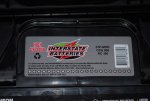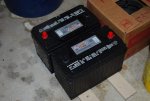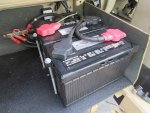Yep. You can confirm this with a digital voltmeter, charging occurs at any voltage over 25.6v, with 28v range being most common.
The stock military alternator has about 4 different common failure modes, of which modern civilian alternators have cured all of. In addition, the modern civilian ones can be had for a very reasonable cost, and will not over-volt on an "improper" dash switch engine shut down, which can damage other electrical components on board such as the PCB, CTIS, and ABS modules.
If you are intent on keeping the truck all original, your original alternator can be repaired or rebuilt. If that is not so important, and you wish to up the reliability with more modern technology, I'd suggest to do the conversion. You can make it not stand out so bad if you paint it to match the engine colors rather than leaving it cast aluminum color if you desire.
If you keep your batteries fresh (< 5 years old), the alternator will quickly replenish them after every start, therefore leaving most of the alternator's capability available for accessory loads. Increasing your alternator's size (output) is also an option, but not required. I strongly recommend it if multiple continuous loads will be present (high wattage power 120V AC inverter, A/C with electric condenser fans, or a lot of lighting). Short term loads like an electric winch or high powered radio transmission, it is OK to pull power from the batteries, as they have plenty to offer and sit bored with nothing to do after the engine has started and is running.
The Cummins civilian alternator bracket is available as a direct bolt onto your 8.3L engine to make this an easy event. Entire job can be done/sourced yourself for about $200 in parts, including a new 70 amp alternator with 1 year warranty. About $350 if you want to step up to 100 amp alternator with bracket (contact Simp), but the 100 amp unit may have less output at idle as compared to a conventional brush type unit (the 100 amp is typically brush-less, longer life but less idle output).





